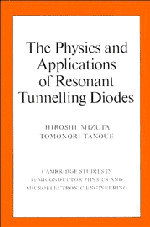Book contents
- Frontmatter
- Contents
- Preface
- 1 Introduction
- 2 Introduction to resonant tunnelling in semiconductor heterostructures
- 3 Scattering-assisted resonant tunnelling
- 4 Femtosecond dynamics and non-equilibrium distribution of electrons in resonant tunnelling diodes
- 5 High-speed and functional applications of resonant tunnelling diodes
- 6 Resonant tunnelling in low-dimensional double-barrier heterostructures
- Index
6 - Resonant tunnelling in low-dimensional double-barrier heterostructures
Published online by Cambridge University Press: 26 January 2010
- Frontmatter
- Contents
- Preface
- 1 Introduction
- 2 Introduction to resonant tunnelling in semiconductor heterostructures
- 3 Scattering-assisted resonant tunnelling
- 4 Femtosecond dynamics and non-equilibrium distribution of electrons in resonant tunnelling diodes
- 5 High-speed and functional applications of resonant tunnelling diodes
- 6 Resonant tunnelling in low-dimensional double-barrier heterostructures
- Index
Summary
This last chapter is devoted to the study of resonant tunnelling through laterally confined, ultra-small, double-barrier heterostructures. Recent rapid advances in nanofabrication techniques have naturally led to the idea of resonant tunnelling through three-dimensionally confined ‘quantum dot’ structures. Since electrons are confined laterally as well as vertically in these structures, the devices are often called zerodimensional (0D) RTDs and have become of great interest both from the standpoint of the physics of quantum transport through 0D electronic states and also for device miniaturisation towards highly integrated functional resonant tunnelling devices. The 0D RTD is a virtually isolated quantum dot only weakly coupled to its reservoirs and thus is well suited to investigating electron-wave transport properties through 3D quantised energy levels. By designing the structural parameters such as the barrier thickness, the quantum well width and dimensionality of lateral confinement, it is possible to realise a ‘quantum dot’ in which the number of electrons is nearly quantised so the effect of single-chargeassisted transport, or the so-called Coulomb blockade (CB), becomes significant. After Reed et al. reported their pioneering work in 1988 on resonant tunnelling through a quantum pillar which was fabricated by electron beam lithography and dry etching, several theoretical and experimental studies have been reported which investigate the mechanism of the observed fine structures. Transport in the 0D RTD is generally much more complicated than that in the conventional large-area RTDs which we have studied so far in this book: problems such as lateral-mode mixing due to a non-uniform confinement potential, charge quantisation in a quantum well and the interplay between resonant tunnelling and Coulomb blockade single-electron tunnelling have recently been invoked for the 0D RTDs. Such difficulties are still far from being fully resolved.
- Type
- Chapter
- Information
- The Physics and Applications of Resonant Tunnelling Diodes , pp. 178 - 235Publisher: Cambridge University PressPrint publication year: 1995



